| Home | What we do | What's on | Yarra Pygmy Perch | Our History | FAQ | Resources | Things to see | Photo Gallery | Contact Us |
|---|

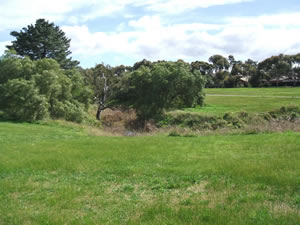
clicking on horizontal lines in the text will bring you back to this contents list
SummaryRiver Red Gum
Blackwood
Black - Golden Wattles
Tangled Lignum
Cumbungi
Common Reed
Other aquatics
Non-indigenous mature trees
Upstream of Barwon Heads RoadPest Plant Species
Cobbin Farm, Highmont Drive
Upstream of Cobbin Farm to Pioneer Road
Upstream of Pioneer Road
Removal Priority 1 Species
Revegetation PlansMap A - Barwon River to Barwon Heads Road
Map B - Barwon Heads to Torquay Roads
Map C - Torquay to Pioneer Roads
Map D - Pioneer to Ghazeepore Roads
Species Recommended for Revegetation
Riparian
Flood-land
Rising Land
The Waurn Ponds Creek valley has little indigenous vegetation following over 150 years of European settlement, although several old River Red Gums, Blackwoods and in-stream aquatics survive.
Some exotic and non-indigenous trees planted over that time provide a small amount of faunal habitat.
Recent planting has focused on locally indigenous trees and shrubs but it has been at an ad-hoc level rather than based on a revegetation plan for the valley as a single ecological unit. These plantings generally lack botanical structure with fewer shrubs and ground-cover plants than are desirable to control weeds.
Important indigenous and planted trees and other vegetation have been identified and sited on plans, and recommendations made for their protection.
Much of the open ground along the valley, between the creek and abutting private property, is regularly mowed however the south side downstream of Torquay Road is a weedy "wilderness."
Major weed infestation, notably of boxthorn, briar, fennel and gorse, have been sprayed and killed, however the dead vegetation remains.
Significant weed species have been listed, sited on plans and their removal prioritised.
Revegetation of the valley downstream of Ghazeepore Road should continue as a whole rather than in piecemeal fashion, using locally indigenous species.
The valley contains three broad zones - the stream banks (riparian), low-lying land (flood-land) and more elevated land (rising) - and planting guides are recommended for each.
A planting plan has been developed recommending species and spacing for the different sites along the valley.
While Waurn Ponds Creek rises in the Barrabool Hills and incorporates a large area of rural land in its headwaters, this report is confined to the section downstream of Ghazeepore Road to the eastern end of the South Barwon Recreation Reserve.
Consequently only limited comment is made of the upstream section and the land at the confluence of the creek with Barwon River.
The significant vegetation may best be described in terms
of
While there are scattered indigenous plants along the creek valley, notable tussock and other grasses, it would be difficult to physically separate them from the overwhelming weed infestation. They are mainly confined to the un-mowed creek banks, but as widespread and intense replanting takes place, their contribution to revegetation will be minimal.
Site inspection prior to herbicide spraying would enable an assessment to be made on the feasibility of protecting any indigenous plants noted at the time.
By contrast, indigenous in-stream vegetation is prolific with Common Reed, sedges and water-ribbons widespread. It is impracticable to plot these plants on plans. Similarly non-invasive aquatic weeds have not been specifically marked on plans since eradication, even control, seems neither necessary nor practicable.
Mowing of the open land has made any formal assessment of the flora difficult, and there appears to be little indigenous vegetation remaining in the overwhelming weed growth.
There are a number of mature Black and Golden Wattles along the corridor, however since these plants are not long lived, they could not be classed as remnants. They may have grown from seeds produced by similariy-aged trees however, given the extent to which both species have been used in earlier replantings, they could not be classed as being of true local provenance.
Individual old trees, some possibly pre-dating European settlement, are scattered along the creek, most at the water's edge.
Other younger trees are also present in fair numbers along the creek, but whether these have been planted or are natural regeneration is not immediately apparent - they are probably a mix of both.
Except where they form an obvious planting, they have been marked on the appropriate maps along with the obviously older trees.
Dead red gums that remain in the creek bed are also recorded since these retain hollows used by fauna.
Risks to existing living trees include storm-damage, insect-attack, vandalism and age-related die-back, while wind and fire are hazards to the dead trees.
The best method of protecting both living and dead trees is to incorporate them into re-planting projects. This should be a priority in determining where revegetation takes place.
This is the longest-living of local wattle species but it seems unlikely any of the trees along the creek pre-date European settlement. Some, however, are likely to be natural regeneration from seed and may retain local provenance genetics.
Others are obviously planted, their provenance unknown.
Because they are a dense-foliaged trees, they are useful bird habitat, and since they are generally long lived, the existing trees should be given protection.
These existing trees should be incorporated into revegetation projects.
There are isolated specimens of both species but, given their relatively short lifespan, they could not be classed a remnant specimens. In addition, although not in plantations, they may have been planted.
There seems little need to specifically protect them given their short lifespan and unknown provenance.
Although it was probably common on the lower reaches of the creek, few plants now exist. While they are useful habitat, there is concern that the plants impeded the flow of the floodwaters.
Replanting of a small number downstream of Bailey Street, particularly on the extensive flood-plain, would be desirable in ecological terms
Another plant seen as an impediment to free flood-water movement, Cumbungi can be invasive to the extent it becomes a dominant part of the stream-bed flora. Some plants exist upstream of Barwon Heads Road but they are not apparently causing any problems at this time.
Leave the existing Cumbungi in-situ unless, or until, it causes demonstrable problems.
Dense beds of Common Reed exist in the lower reaches of the creek and form useful habitat for several species of birds. It is seen as less of a potential problem in relation to impeding flood-waters than Cumbungi.
Leave the existing beds of Common Reed in-tact.
A range of aquatic plants, including sedges, rushes and water-ribbons exist as in-stream vegetation along the creek.
Since there is no need to attempt any revegetation in the waterway at this time, no detailed assessment of these plants has been made.
There are now some non-indigenous Australian trees, and other exotics, that are mature, providing both shelter and food supplies for birds and mammals.
While there should be a long-term strategy of eliminating non-indigenous exotic trees, and a short-term objective of preventing their regeneration, they are fulfilling a habitat need and they should receive some reasonable level of protection until the indigenous species that are planted attain maturity.
There is an added component, however, notably in the case of pines, in the risk to public safety.
Old trees, particularly where they span paths or open, recreational space, need regular, perhaps annual, assessment as to human safety.
The Rotary Club sponsored plantings on the west side of the creek, upstream of Barwon Heads Road, have established well in the short time since they were undertaken.
However, the block nature of plantings tends to over-formalise them, and there is a lack of prickly-foliaged shrubs, e.g. Hedge Wattle, Prickly Moses Wattle, which would help in providing small bird nesting habitat.
The species used, while suitably indigenous, are not fully consistent with those proposed in this report, however there is no suggestion that the plantings should be modified substantially. In the most recent double block, the plants appear to be too closely spaced to fully maximise the number used - the same quantity could have been dispersed over a much larger area.
Future plantings should be planned and carried out according to the accepted layout in this report.
This area has a large number of exotic and non-indigenous Australian trees and shrubs in an area that has high recreational use. Among them are a few invasive plants such as English Ivy, and these should be given high priority in weed removal programs. (see also under Plant Pest Species in following pages.)
However the cultural value of the Cobbin Farm gardens should be protected except where invasive weed species are involved
The planting on the banks in this section of Waum Ponds Creek is very good. It contains a range of locally indigenous species including Manna Gum, River Red Gum, Silver Wattle and Black Wattle.
While the use of Manna Gum in this riparian zone is unfortunate, the trees are growing well and it is possible to integrate them into the planting of the same species on the other sites.
There is, however, no shrub or ground-cover layer, and some phalarus and other weed infestation is of concern. This can be overcome by spraying of the weeds, planting with shrubs and poa tussocks, and mulching.
The Lions Club planting here is successful, however there needs more ground-cover e.g. poa tussocks and shrubs. Existing River Red Gums have been incorporated into the planting providing protection against storm-damage.
There are a number of Tussock Grasses, Poa labillardieri on the north-west side of the creek, upstream and opposite this planting. It would be desirable to protect these plants by incorporating them into any future extension. Herbicide spraying before planting would need to be carefully done.
It is desirable to extend the planting along both banks of the creek upstream of Pioneer Road.
|
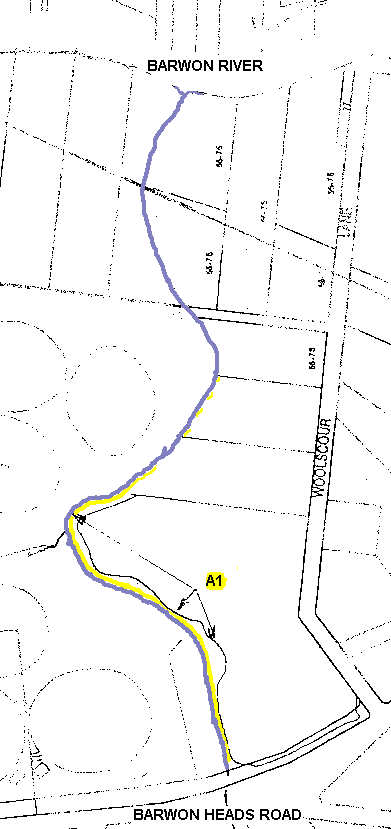
|
| B1 Various
well established plantings (Rotary Club) B2 * Common Reed in-stream B3 Cumbungi in-stream B4 Remnant River Red Gum B5 Blackwood B6 River Red Gum, remnant, dead and several young trees B7 * Common Reed in-stream B8 Small Tangled Lignum B9 Several small River Red Gums B10 River Red Gums B11 Group of River Red Gums, Golden Wattle B12 Several River Red Gums B13 Reasonable planting of wattles B14 Remnant River Red Gum B15 Blackwood B16 River Red Gum B17 Two River Red Gums *Common Reed forms extensive beds in this lower section of the creek. |
| C1 River Red Gums,
several including 1 large dead tree C2 Group River Red Gums, planted C3 Mature River Red Gum C4 2 River Red Gums, 1 old dead River Red Gum, among woody weeds C5 Dead River Red Gum C6 Several Hedge Wattles C7 Dead River Red Gum C8 Small River Red Gum C9 River Red Gum C10 River Red Gum C11 Group River Red Gum C12 Sweet Bursaria C13 River Red Gum C14 River Red Gum C15 4 River Red Gums, Blackwoods among woody weeds C16 This section of the creek has a number of River Red Gums, Black Wattle and Blackwood, but it is seriously infested with (mainly) woody weeds C17 Planted River Red Gums grove C18 Dead River Red Gum C19 2 Dead River Red Gums C20 Dead River Red Gum in area planted with woody weeds C21 Reasonable plantings of indigenous plants C22 Plantings of Manna and some River Red Gums, Silver Wattle and other indigenous species |
| D1 Remnant River Red Gum D2 Remnant River Red Gum well integrated into plantings D3 Poa tussocks on bank D4 Reasonably good plantings D5 Dead River Red Gum in-stream D6 Blackwoods D7 Several River Red Gums planted D8 Some reasonable planting, River Red Gum, Blackwood and Black Wattle, but needs weed removal and understorey and tussock planting, and mulch. D9 Blackwoods D10 Blackwoods D11 Grove of Blackwoods D12 Grove of Blackwoods |
Given the long history of European use of the creek valley, it is hardly surprising that there is a very long list of weeds.
The vast majority of these are pasture grasses and weeds such as plaintains, mallows, brassicas, clovers, vetch, oxalis, thistles etc. There are also some garden escapes, in places the result of illegally dumped garden refuse.
In most cases it is difficult, even impossible, to remove or control them given the continual input of seeds from outside the area. The best treatment would be to provide indigenous plants as competition.
The open grassed areas are mowed regularly and this helps control the weeds by preventing seed-production. This is recommended to continue even as the woodland plantings take place.
There are some serious weed infestation in the un-mown areas along the creek banks which have been controlled by herbicide spraying.
|
Species name |
Common name |
*Priority |
|---|---|---|
| Acacia baileyana Acacia longifolia Acacia iteaphylla Acacia saligna Agapanthus praecox Agave americana Allocasuarina cunninghamii Bambusa sp. Cotoneaster ?glaucophyllus Crataegus monogyna Cupressus sp. Cynara cardunculus Dipogon lignosus Flaxinus rotundifolia Foeniculum vulgare Galenia pubescens Genista monspessulana Hakea suavolens Hedera helix Ligustrum vulgare Lycium ferocissimum Malus sylvestris ?Opuntia sp. Pennisetum claudestinum Phalarus aquatica Phoenix sp. Picris echinoides Pinus radiata Populus ?alba Prunus sp. Pyrus communis Ricinus communis Rosa rubiginosa Rubus fruticosus spp. agg. Salis Sp. Schinus molle Ulex europaeurs Ulmus Sp. Vinca major |
Cootamundra Wattle Sallow Wattle Flinders Ranges Wattle Golden Wreath Wattle Agapathus Century Plant River Sheoak Bamboo Cotoneaster Hawthorn Cypress Artichoke Thistle Dolochus Pea Desert Ash Fennel Blanket Weed Broom Sweet Hakea English Ivy Privet African Boxthorn Apple Cactus Kikuyu Grass Canary Grass Date Palm Bristly Ox-tongue Pine Poplar Plum Pear castor-oil Plant Sweet Briar Blackberry Willow Pepper-com Tree Gorse (furze) Elm Blue Periwinkle |
3 2 4 2 2 3 3 4 2 1 2,4 1 3 1 1 4 1 2 1 1 1 2 3 2 3 4 2 2,4 2 2 4 4 1 1 2 4 1 2 2 |
(Note, this list is in alphabetical, not priority order. All of these 11 species require immediate and on-going control.)
Hawthorn Crataegus monogyna
Not widely distributed along the creek, most of
the plants noted are in the upper third (map D) and near Bailey
Street (map B).
Cut and paint with herbicide in accordance -with Council's management practices.
Artichoke Thistle Cynara cardunculus
Particularly plentiful in the lower sections of the creek where it is generally well-managed by spraying, particularly before flowering. Some plants are further upstream particularly near Ghazeepore Road. Dispersal of seed by wind rather than water means it is usually on flat land well above the creek.
This species should be spot-sprayed before flowering takes place. Mowing/slashing is also effective in preventing it fowering.
Desert Ash Flaxinus rotundifolia
This is a serious environmental woody weed that has had a substantial impact by colonising many sections of the Barwon River riparian habitat.
The major infestations along the Waurn Ponds Creek are upstream of Barwon Heads Road towards Winter Street but there are other plants further along the valley.
Removal of some of the plants has been carried out already, and this should continue. Isolated plants high in the catchment should receive priority treatment to reduce the spread of the species.
Fennel Foeniculum vulgare
Already subject to control by spraying, it is
desirable to continue, even expand, the treatment.
In isolated clumps, or in environmentally sensitive areas close to other plants or the water, cutting and painting may be necessary.
An environmentally invasive weed; management should continue and be expanded.
Broom Genista monspessulana
Another highly invasive weed, there is a large amount growing on the south bank downstream Of Torquay Road to at least Bailey Street.
This should be treated urgently to limit the extent to which it can spread.
English Ivy Hedera helix
Environmentally invasive, ivy is spread in part by the dispersal of seeds by birds.
There is only a small area of ivy, near Highmont Drive, and this should be removed.
Privet Ligustrum vulgare
At the present time (May) most have clusters of ripe berries which may be eaten by some birds, thus potentially extending their distribution. However Privet is a garden plant and fresh introductions in this manner may continue.
A number of bushes have been identified and these should be removed prefereably by cutting and painting the stumps according to Council's woody weed removal procedures.
African Boxthorn Lycium ferocissimum
Except where marked on the attached maps, all boxthorn infestations have been sprayed and killed. The dead bushes remain in-situ and in time these will be an impediment to revegetation. In addition to that, they area harbour for rabbits and sparrows.
However they also serve as cat-proof habitat for wrens and some other native birds, and since most are on the bank of the creek, they help hold the erodable soil together. To physically remove them from the site would damage the creek banks, and the cost would be high.
It is recommended that the dead bushes be burnt in-situ to make revegetation easier and to remove the rabbit harbour, while allowing the roots to remain in the soil.
This would also encourage regrowth of any root-stock and germinate seeds, allowing a follow-up spraying program if necessary.
However, given that wrens and other birds may use the boxthorn for nesting, burning should not take place between August and December.
Any living boxthom bushes should be sprayed according to routine management prescriptions. Those under existing cypress trees should be removed either manually or by use of cut-and-paint methods.
Removal of dead bushes and treatment by spraying or cut-and-paint of living plants be a priority.
Sweet Briar Rosa rubiginosa
A spiny plant that can cause problems in revegetation work because of its stiff branches and hard thorns that cover them.
Most of the briar has been killed by spraying and these plants should be removed. Any growing plants should be sprayed, then removed.
Blackberry Rubus fruticosus spp. agg.
Spraying has controlled the plant to a large extent and any remaining thickets should be treated.
Removal of dead blackberry should be carried out to allow easier revegetation.
Gorse (Furze) Ulex europaeus
As for African Boxthorn detailed above.
|
A1 Desert Ash, mature tree A2 Willow, mature tree A3 Extensive patch of boxthorn A4 Desert Ash, mature tree A5 Bracelet Honey-myrtle, several isolated mature trees A6 Blue Periwinkle, small patch A7 Boxthorn bushes A8 Desert Ash, mature tree A9 Boxthorn A10 Privet, small bush A11 Extensive non-indigenous plantation from which River Sheoak is moving into streamside land A12 Caster-oil Plant, single plant A13 Desert Ash A14 Cypresses, several mature |
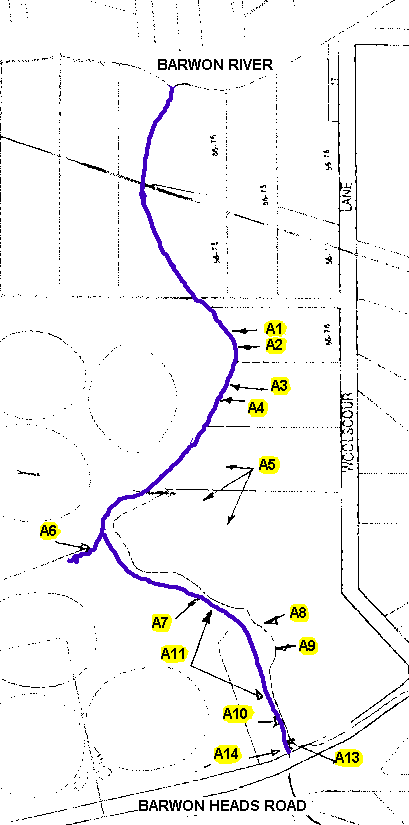
|
| B1 Desert Ash, extensive
infestation B2 Boxthorn, fennel on pipe embankment B3 Boxthorn, fennel, Canary Grass extensive on east side of creek B4 Artichoke Thistles B5 Old cypresses with boxthorn beneath B6 Scattered dead boxthorn B7 Weedy "wilderness" on east side of creek (see B3) B8 Mixed non-indigenous plantings beside houses B9 Scattered dead boxthorn B10 Row of old cypresses, boxthorn beneath, garden refuse B11 Pepper-corn Trees B12 Fennel B13 Live boxthorn B14 Privet, ash, briar B15 Dead boxthorn B16 Broom, briar, fennel, boxthorn B17 Serious infestation of broom, briar, privet, hawthorn - very weedy B18 Broom infestation, also gorse, boxthorn B19 Cypresses, boxthorn B20 Very badly overgrown with gorse, broom, boxthorn, fennel and Artichoke Thistle B21 Non-indigenous plantings at rear fence B22 Weedy, some sprayed; dead boxthorn, fennel, privet, Artichoke Thistle, cactus; garden refuse dumped B23 Century Plant B24 As for B20 B25 Dead boxthorn, fennel B26 2 Sugar Gums B27 Willows, bamboo B28 Non-indigenous planting B29 Boxthorn prunus, elm, fennel, ash B30 Willow B31 Sweet Hakea |
| Cl Weeds among
mixed planting C2 Row of Sugar Gums C3 Elm suckers C4 Both banks weedy C5 4 pines C6 Pepper-corn Trees, apples, dead boxthorn C7 Privet, Pepper-corn Tree, apple C8 Apple, non-indigenous wattle, Pepper-corn Tree C9 Pepper-corn Tree, Century Plant C10 Very weedy, apple, prunus C11 Pepper-corn Tree C12 Large pine C13 Wandering Jew C14 Ash C15 Pepper-corn tree C16 Row of mature pines C17 Weedy with Century Plant, Pepper-corn Tree, ash, prunus C18 As for C17 but contains River Red Gums and Blackwoods C19 as for C18 C20 As for C18 C21 Sallow Wattle C22 Along Highmont Road frontage and adjacent to Cobbin Farm - many mature and well-developed non-indigenous and exotic trees and shrubs. Some of the worst weeds here are ivy, agapanthus, elm, poplar, broom, fennel, cotoneaster, boxthorn, Cootamundra Wattle. This section of the creek will require a close review to ascertain how, and when, removal of the less invasive "habitat' trees should occur. Priority should be given to the control of invasive weeds. C23 Canary Grass, Date Palm among indigenous plantings |
| D1 Kikuyu D2 Non-indigenous plantings D3 Dead gorse D4 Century Plant D5 Dead gorse D6 Dead boxthorn D7 Hawthorn D8 Prunus D9 Dead boxthorn D10 Canary Grass in-stream D11 Dead boxthorn D12 Area grazed, dead boxthorn D13 Dead boxthorn D14 Non-indigenous planting D15 Dead boxthorn D16 Prunus D17 Dead boxthorn D18 Boxthorn D19 Gorse D20 Dead gorse D21 Dead boxthorn D22 Hawthorn, dead gorse D23 Dead boxthorn D24 Century Plants, dead boxthorn D25 Dead gorse D26 Row of pines planted adjacent to new subdivision on south bank now c3m tall, Century Plants, dead boxthorn D27 Dead boxthorn D28 Mature hawthorn, pine, pear; dead briar, fennel, gorse D29 Plantation of pine, cypress, and (mainly) non-indigenous shrubs; boxthorn, fennel, Dolochus Pea, Canary Grass, Artichoke Thistle, blanket weed |
Waurn Ponds Creek is in a linear reserve bounded on both sides by residential or commercial development. In places, the creek,has been mechanically cleaned out, and re-aligned, and for the most part consists of a steep-banked channel in an otherwise flat landscape.
There are some minor flood-plains, and the balance of the land rises gently to the private property boundaries which are mainly above predicted flood level
This creates three main zones, with some minor sub-zones, along the
reserve viz
The initial priority would seem to be the establishment of tree-cover along the water-course. There should be a structure to the planting so that trees, shrubs and ground-cover species develop simultaneously.
In some earlier plantings, there has been an emphasis only on trees and as a result the understorey has become dominated by weeds. This is the case upstream of Cobbin Farm.
Since these weeds, mainly phalarus and similar plants, are easily removed, spraying by Council staff and follow up re-planting with shrubs and ground-covers by volunteers would be appropriate.
There are also sections of the creek, e.g. at Camdell Court, where there are many mature and semi-mature indigenous trees, but there are also many weeds including boxthorn and Pepper-corn Trees.
Since these are substantial plants, it would seem appropriate to allocate their removal to a group like Green Corps or ATCV, rather than inexperienced volunteers. Fill-in planting could be done by either.
The four main sources of labour to undertake the revegetation work
are
Since Council and the Friends group are most closely associated with the project, it would seem appropriate that the sites chosen for replanting be negotiated between the two.
Weed spraying and large tree removal work would be Council responsibility, while volunteer groups working mainly under Friends guidance would be best used as tree-planters.
The first areas to be planted should be on both banks along the creek
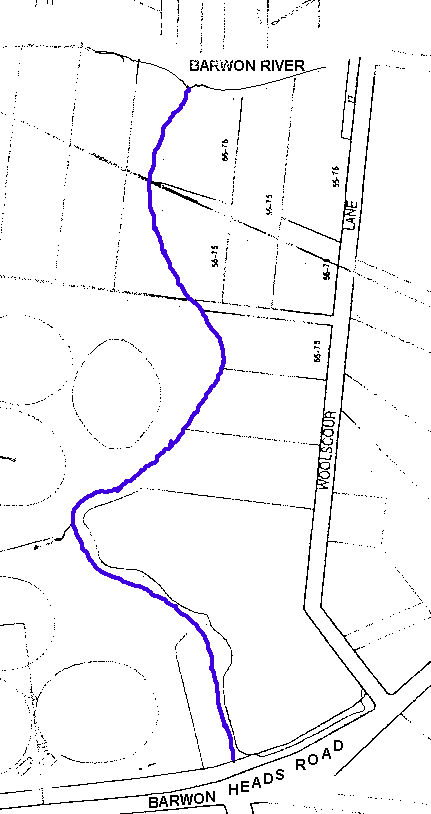
|
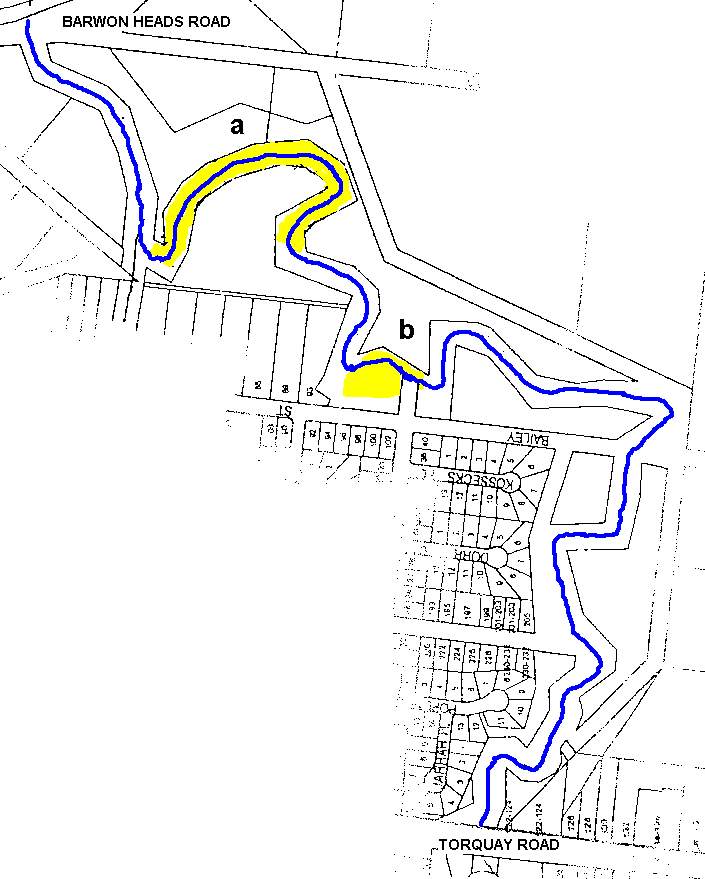
|
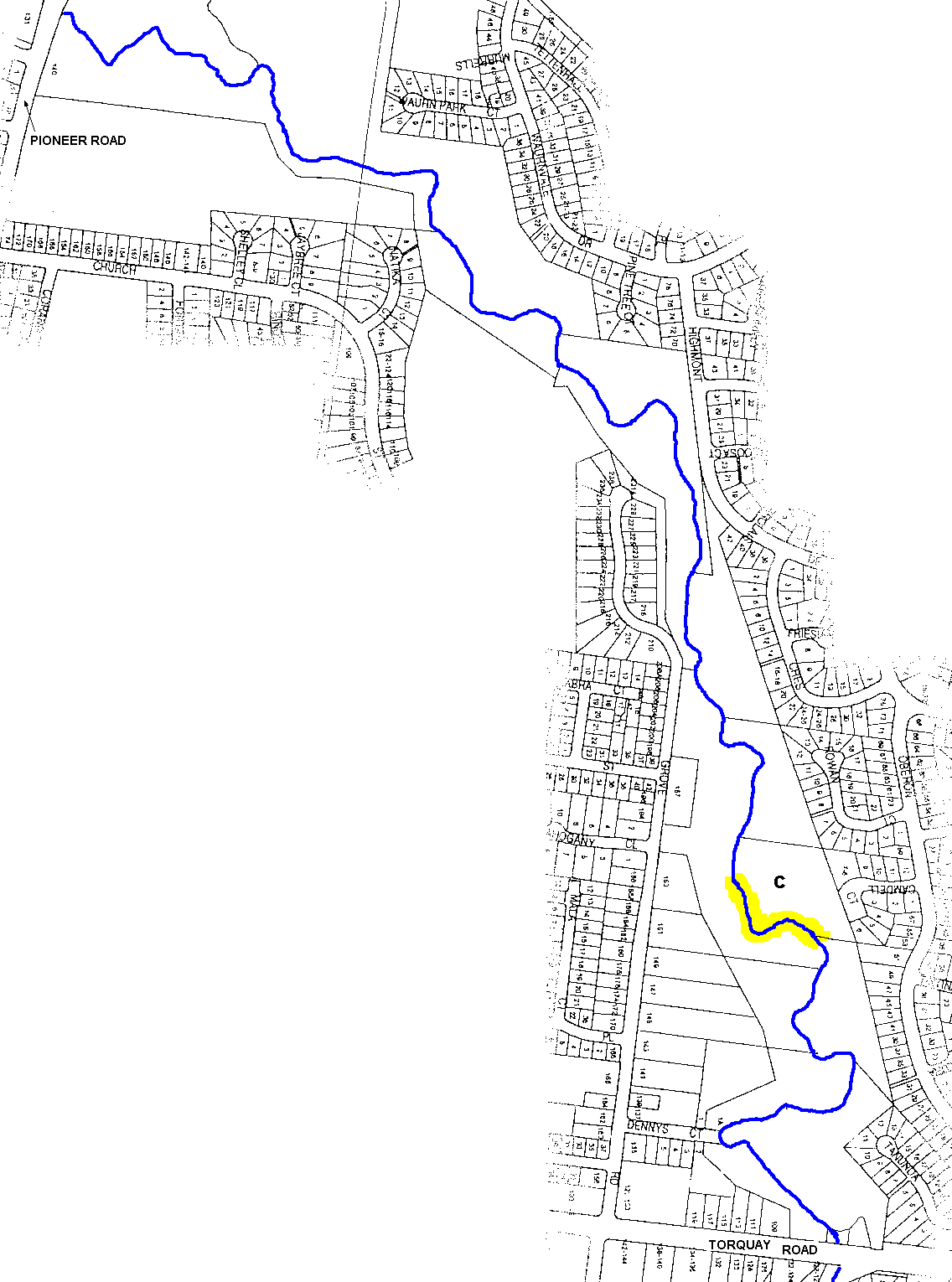
|
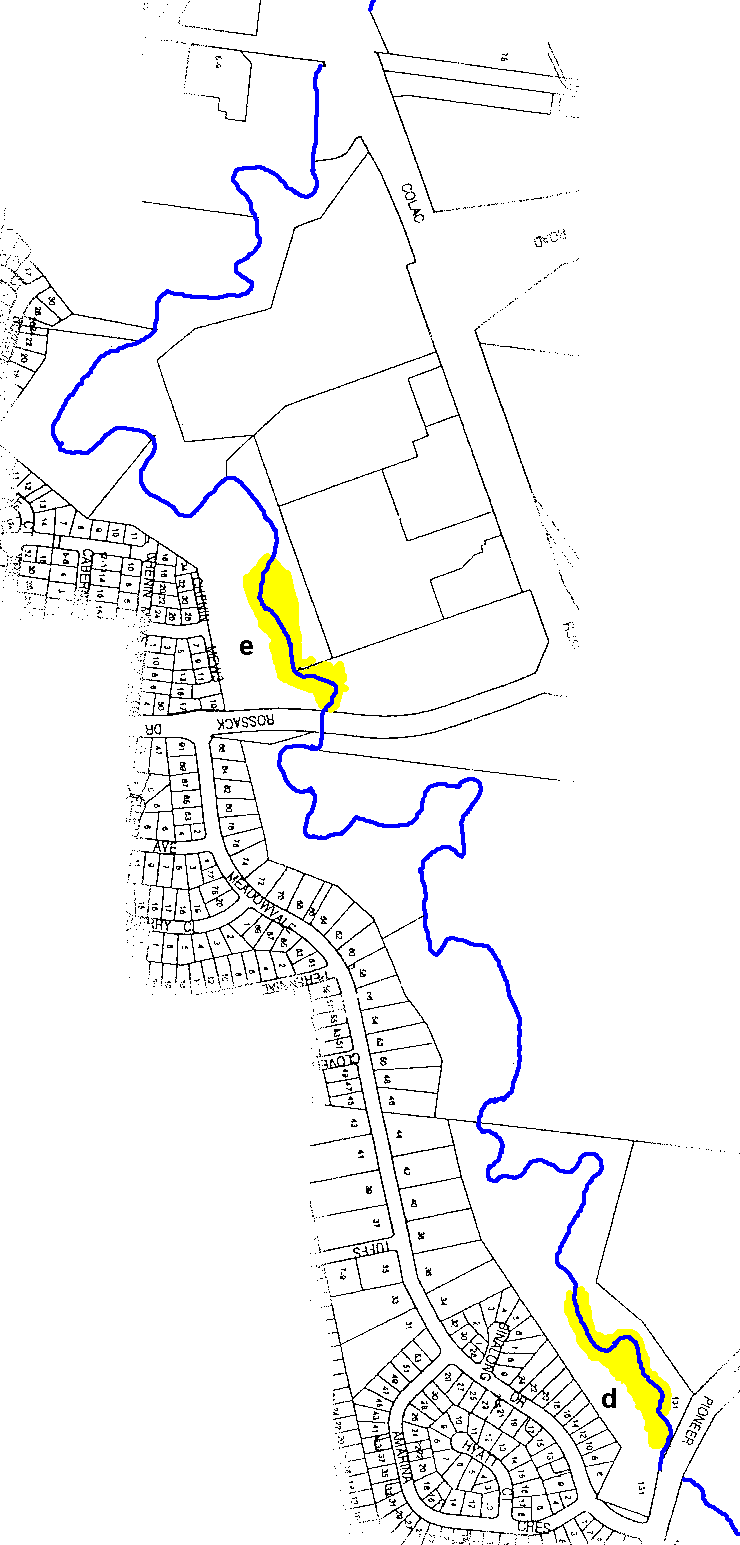
|
Some community interest has already been shown at all except the Rossack Drive site, and this should be supported as soon as possible.
With Council, Barwon Water and C.C.M.A currently carrying out revegetation along the Barwon River corridor, an objective of the Waurn Ponds Creek work should be to connect with and integrate into the existing and future work along the river and on Belmont Common.
To measure the success of the revegetation it is recommended that
|
Name |
Common Name |
Site |
Size |
Spacing |
||
|---|---|---|---|---|---|---|
| Acacia dealbata Acacia mearnsii Acacia melanoxylon Acacia paradoxa Acacia pycnantha Acacia verticillata Allocasuarina stricta Atriplex semibaccata Bursaria spinosa Callistemon paludosa Clematis microphylla Coprosma quadrafida Dianella revoluta Dodonaea viscosa ssp. cuneata Eucalyptus camaldulensis Eucalyptus ovata Eucalyptus viminalist Goodenia ovata Gynatrix pulchella Helichrysum dendroideum Hymenanthera dentata Leptospermum lanigerum Lomandra longifolia Muehlenbeckia cunninghamii Myoporum viscosum Olearia ramulosa Pelargonium australe Poa labillardierii Rhagodia candolleana Solanum laciniatum Themeda triandra Vittadinia sp. |
Silver Wattle Black Wattle Blackwood Hedge Wattle Golden Wattle Prickly Moses Wattle Drooping Sheoak Berry Salt-bush Sweet Bursaria River Bottlebrush Small-leaf Clematis Prickly Currant-bush Black-anther Flax-lily Wedge-leaf Hop-bush River Red Gum Swamp Gum Manna Gum Hop Goodenia Hemp Bush Tree Everlasting Tree (Shrub) Violet Woolly Tea-tree Spiny-headed Mat-rush Tangled Lignum Sticky Boobialla Twiggy Daisybush Austral Stork's-bill Tussock Grass Sea-berry Salt-bush Kangaroo Apple Kangaroo Grass New Holland Daisy |
R R R R R R R R R R R R R R R R R R R R |
F F F F F F F F F F F F |
P P P P P P P P P P P P P P P P P P P P P P |
T T T S T S T S S S C S G S T T T S S S S S G S S S G G S S G G |
2-4 1-3 2-4 1-3 R R R R R 1-3 R R 0.5-1 R 2-5 3-6 R R R R R 1-3 0.5-1 R R R 0.5-1 0.5-1 R R 0.5-1 R |
|
The bed of the creek with its aquatic in-stream vegetation, the often-steep banks, and a short distance on top of the banks, are included in this definition. Depending on the alignment of the creek, the width of bank-top varies from only 2m on the outside of the bend to 4-5m, or more, on the inside bend. The objective is to vegetate this section with trees, shrubs, tussocks, flax-lilies and mat-rushes densely enough to provide a closed canopy and inhibit weed growth. Mulch would be applied to the flat land on top of the banks. Maintenance would be confined to removal of weed infestation and occasionally the re-placement of mulch if this is required. |
|
| Trees |
Shrubs |
Other |
|---|---|---|
| River Red
Gum Blackwood Black Wattle Silver Wattle Drooping Sheoak |
Berry Salt-bush Hop Goodenia Prickly Currant-bush Sticky Boobialla Hemp Bush River Bottlebrush Kangaroo Apple Prickly Moses Wattle Hedge Wattle Woolly Tea-tree Sea-berry Salt-bush |
Black-anther
Flax-lily Spiny-headed Mat-rush Small-leaf Clematis Tussock Grass |
|
Particularly in the lower reaches of the creek, there are areas which are inundated with even minor floods such as occur in most years. As the creek reaches Bailey Street, and on to Barwon Heads Road, these flood-lands become more extensive. The objective is to vegetate this lower-lying land with Swamp Gum, tea-trees, bottlebrushes, goodenia, lignum and tussocks to form an open woodland environment through which flood-waters can easily flow. Maintenance would be confined to litter and invasive weed infestation removal. |
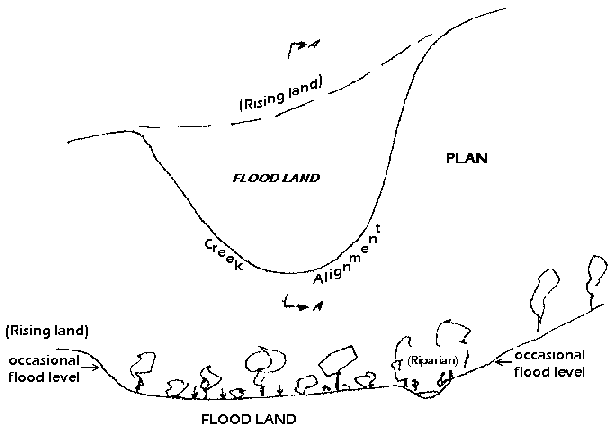
|
| Trees |
Shrubs |
Other |
|---|---|---|
| Swamp Gum Silver Wattle Black Wattle Blackwood Golden Wattle |
Woolly Tea-tree River Bottlebrush Prickly Moses Wattle Tangled Lignum Hop Goodenia Kangaroo Apple |
Tussock
Grass Black-anther Flax-lily Spiny-headed Mat-rush |
|
The majority of the creek reserve consists of parkland through which cycle-pedestrian paths meander. There are picnic areas, seats and other furniture suitable for use in informal recreation. Most of the area is mowed regularly to minimise grass and weed growth. The objective here is to further enhance the open parkland environment with scattered Manna Gums and copses of other shrubs and grasses. Maintenance will continue as it is currently undertaken with some additional weed control around the trees and copses. |
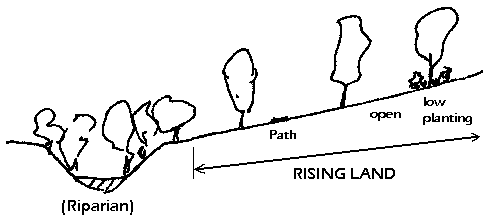
|
| Trees |
Shrubs |
Other |
|---|---|---|
| Manna Gum Drooping Sheoak Black Wattle Golden Wattle |
Hop Goodenia Tree Violet Sweet Bursaria Sticky Boobialla Hedge Wattle Berry Salt-bush Wedge-leaf Hop-bush Tree Everlasting Twiggy Daisybush Sea-berry Salt-bush Kangaroo Apple |
Tussock
Grass Kangaroo Grass New Holland Daisy Black-anther Flax-lily Spiny-headed Mat-rush Small-leaf Clematis Austral Stork's-bill |